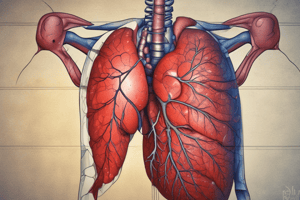Podcast
Questions and Answers
What is cirrhosis?
What is cirrhosis?
- A mild, reversible disease affecting the liver cells
- A condition causing normal hepatocyte conversion into healthy nodules
- An acute disease leading to hepatocyte regeneration
- A severe, chronic, irreversible liver disease characterized by fibrosis of the hepatic parenchyma (correct)
What happens as a result of continued hepatocyte death in cirrhosis?
What happens as a result of continued hepatocyte death in cirrhosis?
- The hepatic parenchyma becomes unaffected
- The liver cells regenerate at an accelerated rate
- The fibrous scar tissue is replaced by healthy hepatocytes
- The number of normally functioning liver cells reduces further (correct)
What is the consequence of cirrhosis on the liver cells?
What is the consequence of cirrhosis on the liver cells?
- Conversion into structurally normal nodules
- Enhanced regeneration and multiplication of hepatocytes
- Destruction and replacement by fibrous scar tissue (correct)
- Decreased fibrosis in the hepatic parenchyma
What is the process that defines cirrhosis?
What is the process that defines cirrhosis?
Flashcards are hidden until you start studying
Study Notes
Understanding Cirrhosis
- Cirrhosis is a late-stage liver disease characterized by scarring (fibrosis) of the liver tissue.
- It results from chronic damage to the liver caused by factors such as alcohol abuse, viral hepatitis, and non-alcoholic fatty liver disease.
Consequences of Continued Hepatocyte Death
- Persistent death of hepatocytes (liver cells) leads to inflammation and necrosis, disrupting normal liver function.
- The continuous process results in compensatory hyperplasia, where the liver attempts to repair itself, increasing the risk of further cellular damage.
Impact on Liver Cells
- Cirrhosis leads to the replacement of healthy hepatocytes with fibrous tissue, impairing the liver's ability to perform essential metabolic processes.
- Structural changes in the liver architecture can alter blood flow and exacerbate liver dysfunction.
Defining Process of Cirrhosis
- The development of cirrhosis involves a progressive cycle of liver injury, inflammation, and regeneration followed by fibrosis.
- This process culminates in significant loss of liver function, resulting in complications such as portal hypertension and liver failure.
Studying That Suits You
Use AI to generate personalized quizzes and flashcards to suit your learning preferences.



